Juventus finished outside the top three in each of the past three seasons but have started 2023-24 well. Ahead of Sunday’s Derby d’Italia with Serie A leaders Inter, we look at what they’re doing right.
Last season’s Serie A campaign wasn’t so much of a title race but a rightful crowning of deserved champions Napoli, who played splendid football under Luciano Spalletti’s guidance.
They were the third different champion the Italian top flight had seen in as many seasons, the continuation of a refreshing change of pace after years of Juventus dominance.
This season, however, Massimiliano Allegri’s charges look up for a fight to regain their crown as kings of Italy, sitting second after 12 games and six points ahead of AC Milan in third. With Simone Inzaghi’s Inter the standout contender for the title so far this season, are Juventus ready to make a comeback?
Juventus 2.0
Five wins in their last five league games has sparked the question of Juventus’ potential return to the top. They haven’t scored more than two in any of those games and won four of them by a one-goal margin, but it’s their longest winning streak since a run of eight between October 2022 and January 2023.
Juventus 2.0 seems well and truly under construction, but what’s different? Well, for one, the squad is younger. Leonardo Bonucci, Juan Cuadrado and Ángel Di Maria all left for pastures new, and the average age of their starting XI dropped from 28 years and 57 days last season to 26y, 334d this season. They were the third oldest, now they’re the ninth-youngest.
Replacing those old warhorses have been youngsters like Federico Gatti and Timothy Weah, the latter signed this summer from Lille in Ligue 1.
Gleison Bremer seems to have taken up the mantle as the leader at the back alongside the relatively inexperienced Gatti as well as Daniele Rugani, with the seasoned Alex Sandro only having played twice so far this season due to injury. Staying true to their defensive principles, Allegri’s Juventus 2.0 are compact and unashamedly defence-first in their 5-3-2 shape off the ball, as shown below.
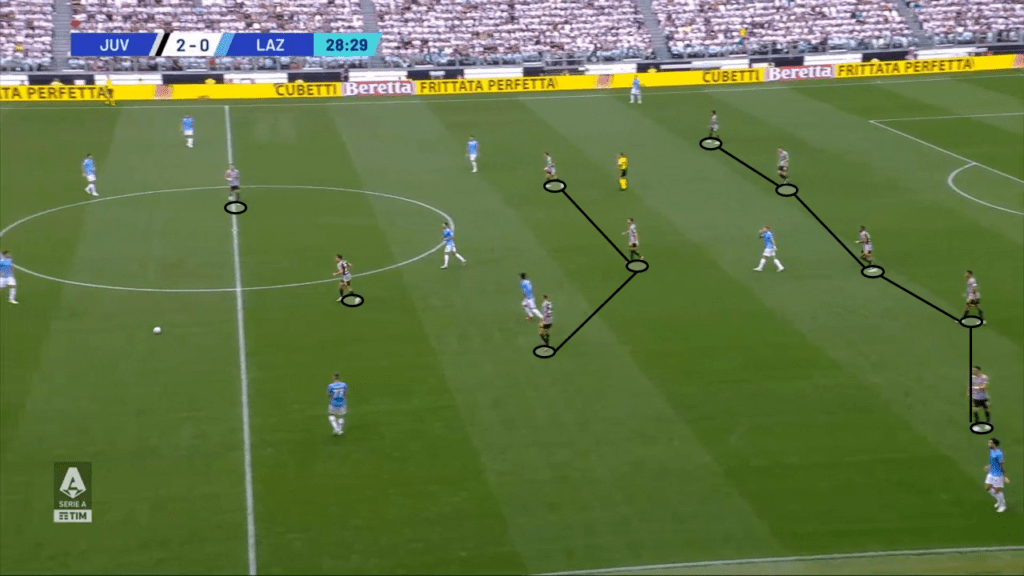
In this shape, they are more likely to sit back rather than draw opposition mistakes by engaging them in pressing duels. We can get an understanding of a team’s pressing intensity (or lack of) by looking at the average number of passes they allow the opposition to have before registering a defensive action (PPDA); the higher the figure, the less intense the pressing, and Juventus’ 14.8 PPDA this season is the fifth-highest in Serie A this term, showing just how static and obdurate they can be to play against.
What’s even more striking is that no team in the Italian top flight have cleared the ball (256) more often than Juventus. For context, league leaders Inter have made the second-fewest clearances (141). Generally, you expect better teams to rank low in this metric because they don’t tend to be under as much pressure, but this further highlights Juve’s defence-first approach.
In possession, the wing-backs occupy much higher positions on the pitch, allowing the centre-backs to carry and bring the ball out from the back when they can. Allegri’s style also demands a great deal of work from the outside eights either side of Manuel Locatelli, who is typically the regista – or tempo-setter – in the side. Though this isn’t a role he’s always performed, Juve’s aversion to a front-foot system means he’s rarely exposed in the middle of the park.
A lot of this is down to the eights, Adrien Rabiot and either Fabio Miretti or Weston McKennie, all three of whom are industrious midfielders comfortable covering ground when required, ensuring Locatelli’s role as the defensive screen is constant.
And while that is the case, Locatelli’s responsibilities go beyond acting as a shield – spraying passes into the opposition half and finding runners in behind are two important functions, with many of his progressive passes coming in the form of long balls to wing-backs and wingers, especially to the right.
The sheer number of passes and their spread across the pitch hints at Locatelli’s importance to the team in retaining possession and dictating play, completing 52 progressive passes this season, a figure bettered by only six outfielders in Serie A.
Additionally, his successful passes upfield have covered 4,213 metres, nearly 200m further than any other midfielder in the division. A player with such influence can be particularly crucial in matches when Juventus aim to dominate possession or break down stubborn defences, especially for an Allegri side that can often seem unprepared when they have more of the ball.
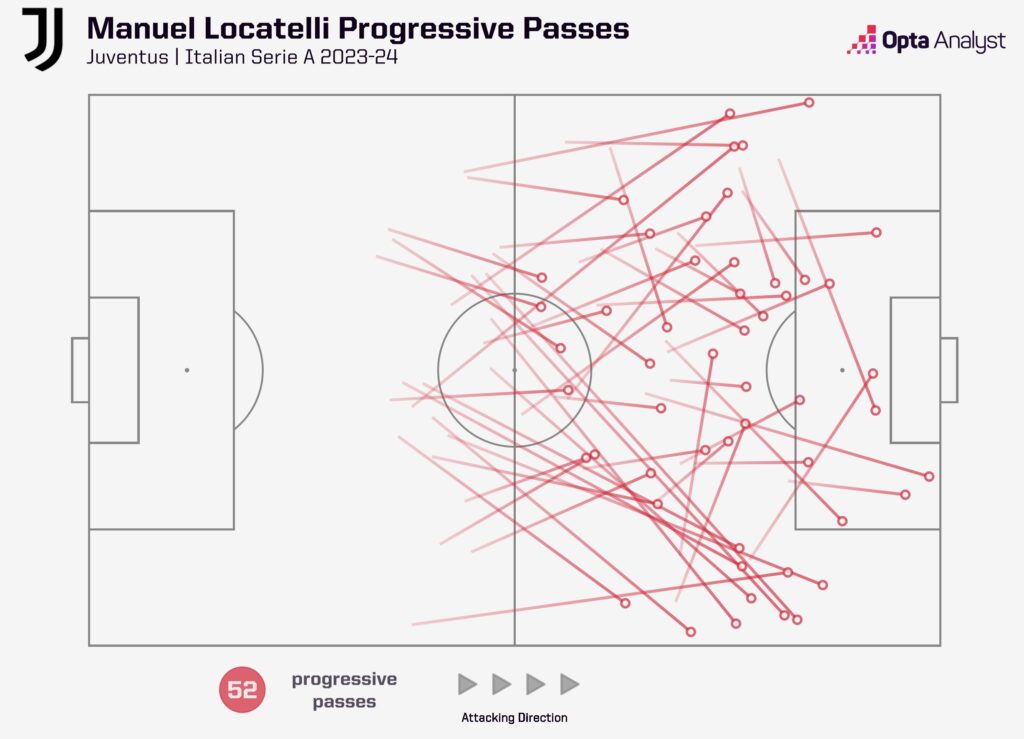
But finding a way through – or around – a packed defence wouldn’t necessarily be the chief purpose of Locatelli; chance creation in Allegri’s side comes predominantly via crossing and there aren’t many better to maximise that approach than Serbian midfielder Filip Kostić, who has picked up where he left off last season, when he scored three and assisted eight in the league.
The ball often funnels to his flank when looking to service the likes of Federico Chiesa and Dusan Vlahović. His variety in final-ball delivery means opposition defences always have to be smart about the space they concede to him.
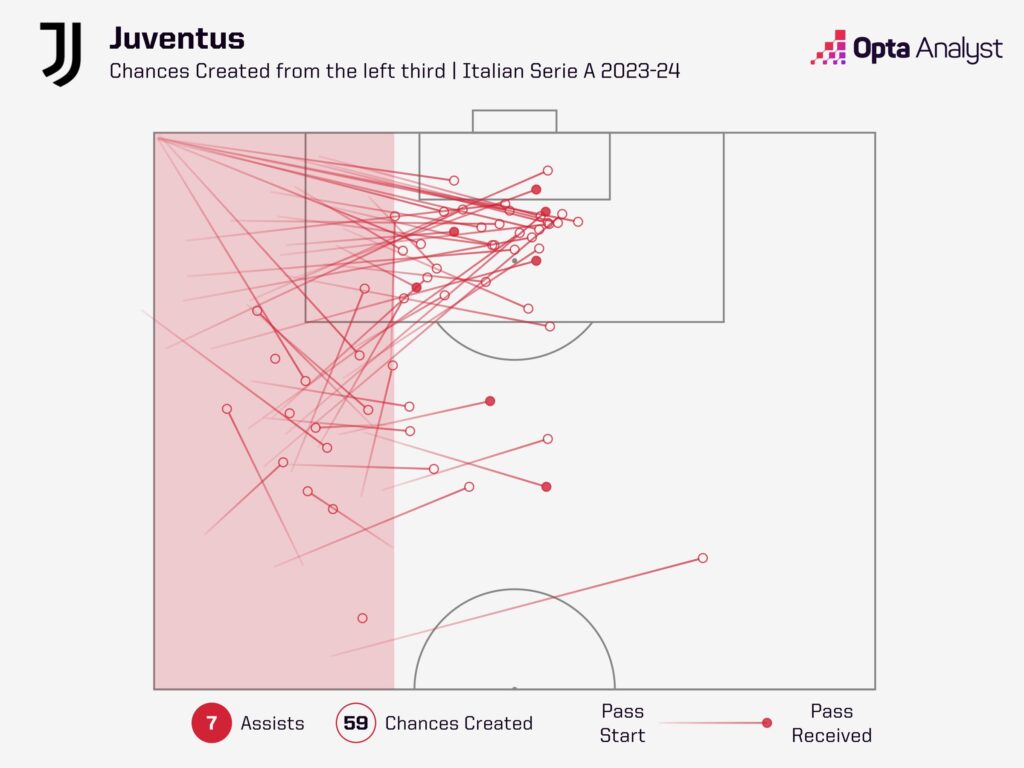
Kostić is likely a big reason why only Inter (54), Atalanta (49) and Cagliari (47) have completed more open-play crosses than Juventus (44); after all, he made a name for himself in the Bundesliga as a crossing machine.
Looking at his shot assists begins to explain the story behind Juventus on the left. He’s created 24 chances in total, joint-sixth most in Serie A, with 15 from open play. The vast majority, as you can see from the graphic below, are delivered with precision into the middle of the penalty area.
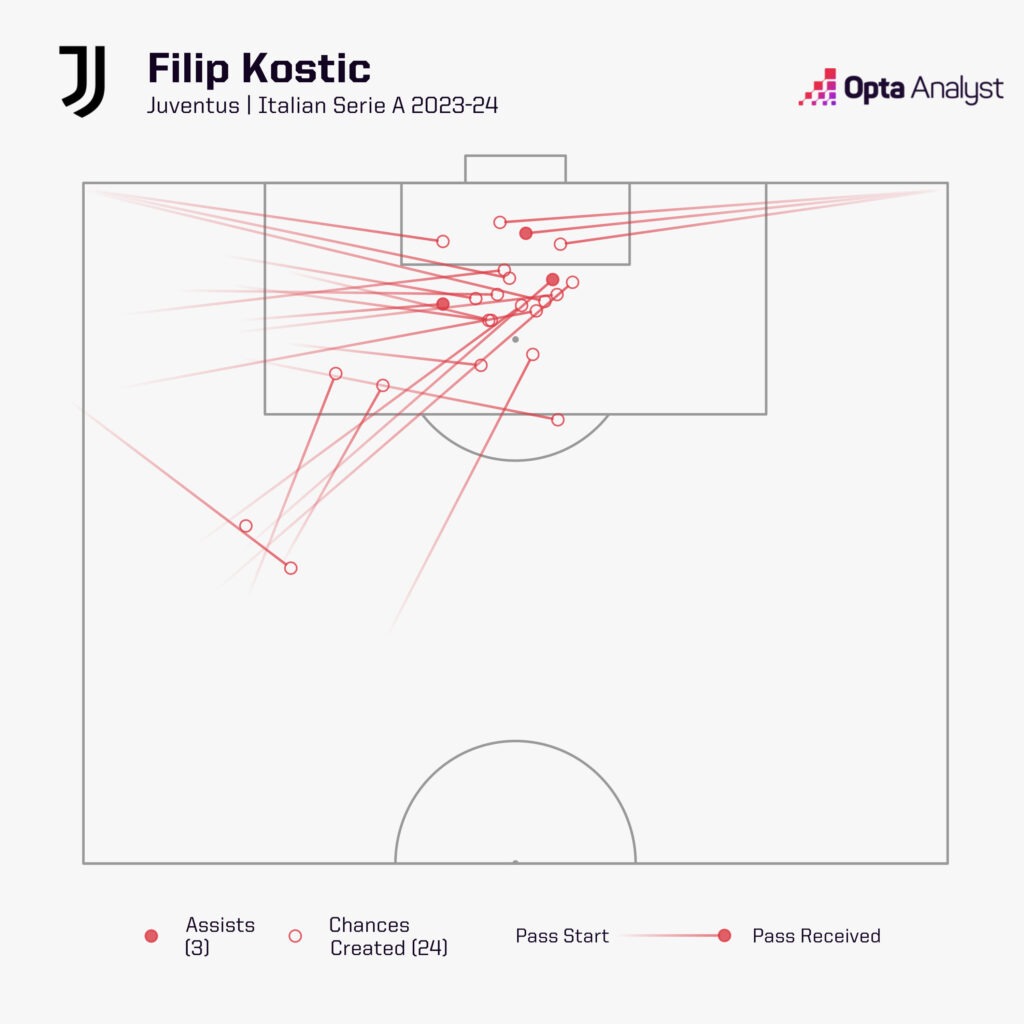
Their origin may change, whether it’s the corner flag, high and wide on the flank, or in the half spaces, but the standard and aim of deliveries rarely wavers – it all points to the most valuable area of the box: the central spaces.
Juventus often progress the ball via the left channels, especially in advanced and wide areas of the opponents’ half. This pattern highlights Kostić’s influence, as 8.8% of progressive passes are made from the left side, where he predominantly plays. In the attacking third, Juventus record 24.4% of their progressive passes on the left, nearly double the 12.4% seen on the right.
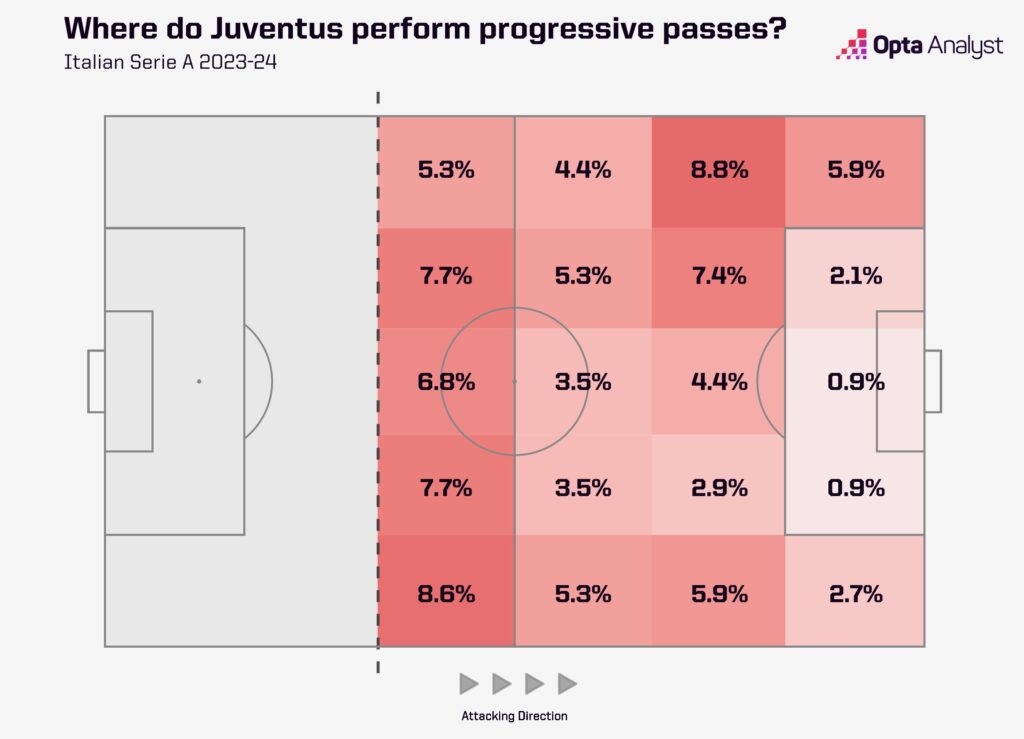
The Bigger Picture
But what does this all feed into for the Bianconeri?
Looking at Juventus’ attacking production this season, first in terms of volume, their 176 shots sees them rank third across Serie A. As for quality, their 18.7 non-penalty expected goals is second only to Inter (20.3).
Allegri’s Juventus are adept at crafting not just a significant number of opportunities but high-quality ones as well. The consistency between their actual non-penalty goals (18) and non-penalty xG (18.7) suggests they aren’t merely riding a wave of overperformance; they’re hitting their mark consistently. So, as the data indicates, Juventus are performing to expectation in terms of their attacking output.
Looking at where they score their goals helps understand Juventus even more: they dominate the danger zone.
They’ve scored the highest proportion of goals in the six-yard box (33%) relative to any other team in Serie A this season, followed by Milan (25%). However, their record of scoring 83% of their goals inside the penalty area is only better than three clubs, highlighting potential room for improvement going forward for Allegri, meaning they might be too eager to get shots off outside the box.
While scoring 17% of your goals outside the box showcases the team’s ability to threaten from distance, it might also indicate a tendency to shoot from less optimal positions, which could be due to an inability to break down an opposition’s backline.
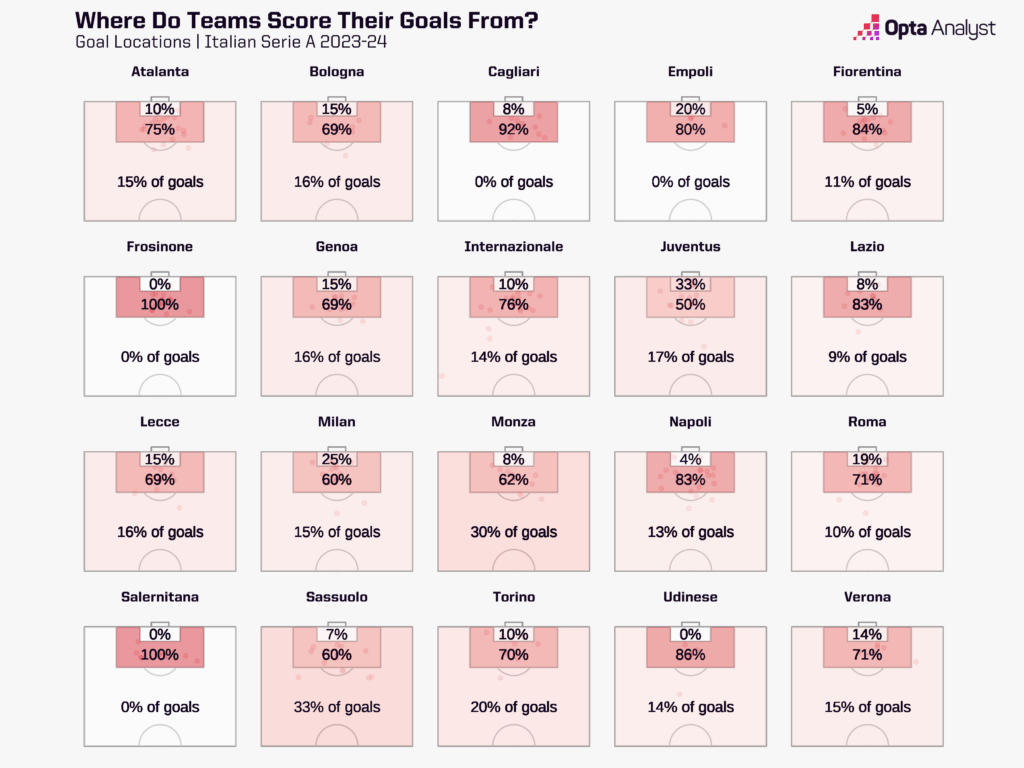
But such frustrations aside, Allegri’s team have certainly become an annoyance themselves. Conceding an average of just 0.65 xG against per game, they face fewer high-quality chances than any other team in Serie A, even ahead of Inter (0.70). Once again, it’s difficult to ignore the compactness referenced earlier, and their dogged nature in denying space.
So, back to our initial question: are Juventus “back”? The evidence suggests that, at the very least, they’re right where they’re supposed to be at the moment.
And while that should be reassuring to Allegri and the fans, Sunday’s Derby d’Italia at home to Inter is the proper litmus test; they’ve got the perfect opportunity to make a statement and send a signal to their rivals, but failure will highlight how much work is still ahead of them.
Enjoy this? Subscribe to our new football newsletter to receive exclusive weekly content. You should also follow our social accounts over on X, Instagram, TikTok and Facebook.
